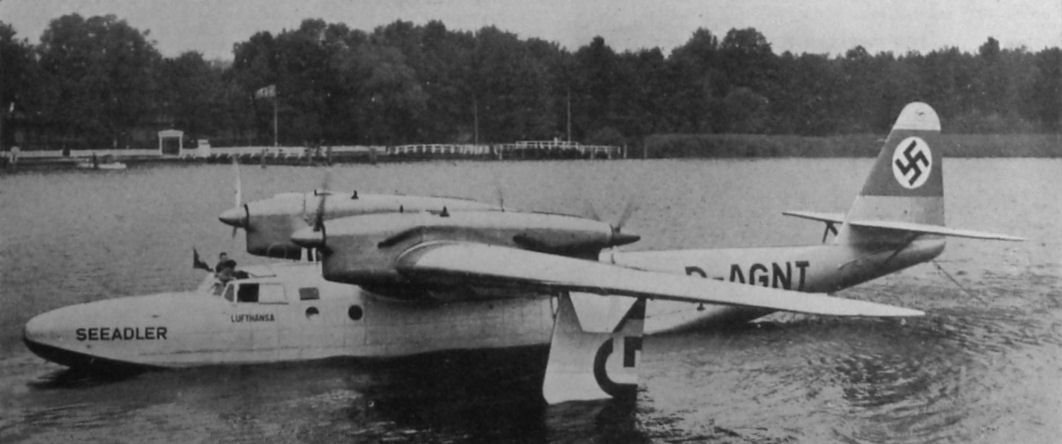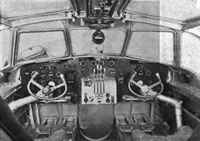
Описание
Страна : Германия
Год : 1938
Летающая лодка
Патрульная и транспортная летающая лодка с экипажем из четырех человек
Do.26
Dornier Do 26
Предназначенная для трансокеанских почтовых перевозок цельнометаллическая летающая лодка Do 26 стала самым изящным гидропланом компании "Dornier". Машина с экипажем их четырех человек предназначалась для доставки 500 кг почты на линии Лиссабон - Нью-Йорк. Стабилизирующие поплавки в полете полностью убирались в крыло и заднюю часть мотогондол дизелей Junkers Jumo 205C мощностью по 600 л.с. (дизели монтировались попарно тандемом). Перед взлетом мотогондолы поднимались на угол 10° для снижения забрызгивания корпуса трехлопастными винтами. Три Do 26, заказанных в 1937 году компанией "Deutsche Lufthansa", изготовили в усиленном варианте для запуска с катапульт судов обеспечения, первый из них поднялся в воздух 21 мая 1938 года. Авиакомпания получила эти самолеты под обозначением Do 26A; по предназначению, для полетов через Северную Атлантику, лодки не использовались, но выполнили 18 перелетов через Южную Атлантику.
Варианты
Do 26B: обозначение изначально было закреплено за третьей летающей лодкой, которую предполагалось построить с кабиной большего объема, допускающей перевозку четырех пассажиров; самолет собран как первый Do 26D
Do 26D: четыре Do 26D-0 построены для Люфтваффе с силовой установкой большей мощности и оборонительным вооружением; к апрелю 1940 года летающие лодки вместе с двумя самолетами "Lufthansa" использовались для транспортных перевозок во время кампании в Норвегии; Do 26D состояли на вооружении подразделений Transocean Staffel и позже Kustenfliegergruppe 406
ТАКТИКО-ТЕХНИЧЕСКИЕ ХАРАКТЕРИСТИКИ
Dornier Do 26D-0
Тип: патрульная и транспортная летающая лодка с экипажем из четырех человек
Силовая установка: четыре дизеля Junkers Jumo 250D мощностью по 800 л. с.
Летные характеристики: максимальная скорость на высоте 2600 м - 323 км/ч; крейсерская скорость на оптимальной высоте 257 км/ч; время набора высоты 2000 м -16 мин 30 с; практический потолок 4500 м; дальность 4800 км
Масса: пустого 11300 кг; максимальная взлетная 22 500 кг
Размеры: размах крыла 30,00 м; длина 24,60 м; высота 6,85 м; площадь крыла 120,00 м;
Вооружение: одна подвижная 20-мм пушка MG151/20 в носовой части корпуса, три пулемета MG15 калибра 7,92 мм в стрелковых установках над и по бокам корпуса
Полезная нагрузка: до 12 солдат
Описание:
- Do.26
- Flight, September 1938
A REMARKABLE DORNIER BOAT
Фотографии
-
Jane's All the World Aircraft 1938 / 03 - All the world's aeroplanes
Регистрационный номер: D-AGNT [12] The Dornier Do.26 Long-range Postal Flying-boat (four 600 h.p. Junkers "Jumo 205" heavy-oil engines)..
-
Aeroplane Monthly 1988-06 / J.Stroud - Wings of Peace
Регистрационный номер: D-AGNT [12] The Do 26V1 D-AGNT Seeadler in pristine condition.
-
Aeroplane Monthly 1988-06 / J.Stroud - Wings of Peace
Регистрационный номер: D-AGNT [12] THE LATEST DORNIER: When compared with the similar view overleaf, this photograph of the new Dornier Do.26 is particularly interesting. In this case the outboard floats are retracted and the machine is running on the step at a speed high enough for lateral control to be available. The Do.26 is designed for catapult work.
Seeadler taking off; on this occasion the rear engines have not been raised. The floats have already been retracted.
Originally planned as a long-range mail-carrying type it is believed to have been adopted by the Luftwaffe for long-distance reconnaissance and bombing. -
Jane's All the World Aircraft 1938 / 03 - All the world's aeroplanes
A close-up view of the Dornier Do.26 showing the rear engines tilted for taking-off.
-
Aeroplane Monthly 1988-06 / J.Stroud - Wings of Peace
Регистрационный номер: D-AGNT [12] Seeadler with the rear engines inclined at 10°.
-
Aeroplane Monthly 1988-06 / J.Stroud - Wings of Peace
Регистрационный номер: D-AGNT [12] This view of the first Do 26 clearly shows the gull wing and tandem engine layout.
-
Aeroplane Monthly 1988-06 / J.Stroud - Wings of Peace
Регистрационный номер: D-AGNT [12] The Do 26 D-AGNT Seeadler, showing signs of use.
-
Flight 1939-04 / Flight
Регистрационный номер: D-AGNT [12] A view including the Dornier Do.26 four-engined long-range flying boat (on the water) and the earlier Do.18.
Другие самолёты на фотографии: Dornier Do.18 - Германия - 1935
-
Aeroplane Monthly 1988-06 / J.Stroud - Wings of Peace
Регистрационный номер: D-AGNT [12] This view of Seeadler being lowered onto the Friesenland’s catapult is one of the best showing the planing bottom and steps.
-
Aeroplane Monthly 1988-06 / J.Stroud - Wings of Peace
Регистрационный номер: D-AGNT [12] FORCEFUL ASSISTANCE: The new Dornier Do. 26 leaving the D.L.H. Atlantic supply ship Friesenland. At the moment the machine was loaded up to an all-up weight of 19,000 k.g. (42,000lb.).
The first Do 26 immediately after a catapult launch. -
Flight 1938-09 / Flight
Designed expressly for the North Atlantic service, the latest four-engined Dornier flying boat, the gull-winged Do. 26, incorporates many unusual features. Lateral sponsons, characteristic of Dornier boats, have been replaced by retractable wing floats.
-
Jane's All the World Aircraft 1938 / 03 - All the world's aeroplanes
A front view of the Dornier Do.26 Long-range Postal Flying-boat.
-
Мировая Авиация 110
V5 - прототип восьмиместной лодки Do 26C был принят на вооружение Люфтваффе.
Dornier Do 26 in Luftwaffe service. -
Авиация и Космонавтика 1996-11 / ??? - Самолеты Люфтваффе (9)
В полете Do 26C
-
Flight 1939-04 / Flight
An example of duplicated instrument-flying panels - interesting because it is the control cabin of the Dornier Do.26 four-engined transatlantic flying boat. Notice the two distant-reading compass dials at the top of the panels.
With a separate engineer’s control panel, it has been possible to simplify the layout of the new Dornier’s instrument board. Note the twist-grips on the spectacle controls and the accessibility of the D/F loop gear. -
Aeroplane Monthly 1988-06 / J.Stroud - Wings of Peace
View of a Do 26 flight deck. The door in the centre gave access to the mooring compartment.
-
Flight 1938-09 / Flight
On the Dornier Do.26 the engineer sits aft, in front of a comprehensive instrument panel, thereby relieving the pilots of a good deal of instrument-watching and engine control adjustment. The engineer has access to all four engines.
-
Flight 1938-12 / Flight
Регистрационный номер: D-AGNT [12] The French President, who displayed great technical knowledge during his tour of the stands, engrossed in the large scale model of the four-Diesel transatlantic Dornier.
-
Aeroplane Monthly 1988-06 / J.Stroud - Wings of Peace
Регистрационный номер: D-AGNT [12] KEITH WOODCOCK'S painting clearly shows the clean lines of the Dornier Do 26.
- Фотографии




















